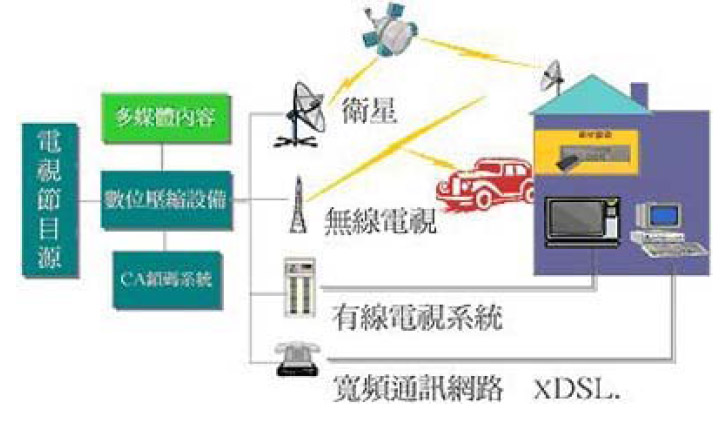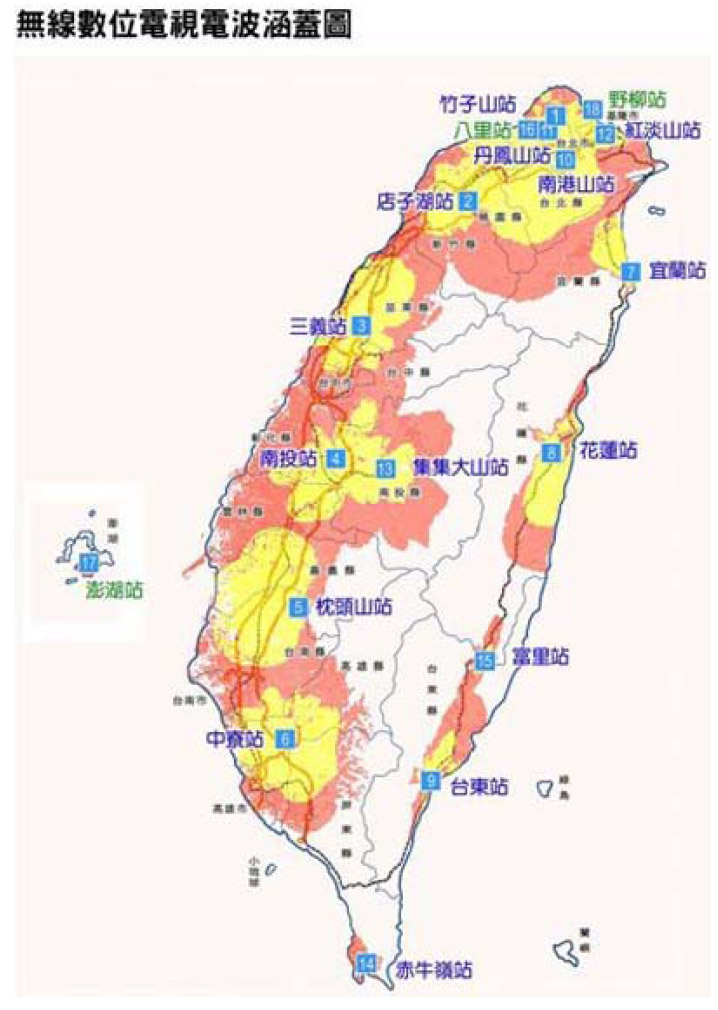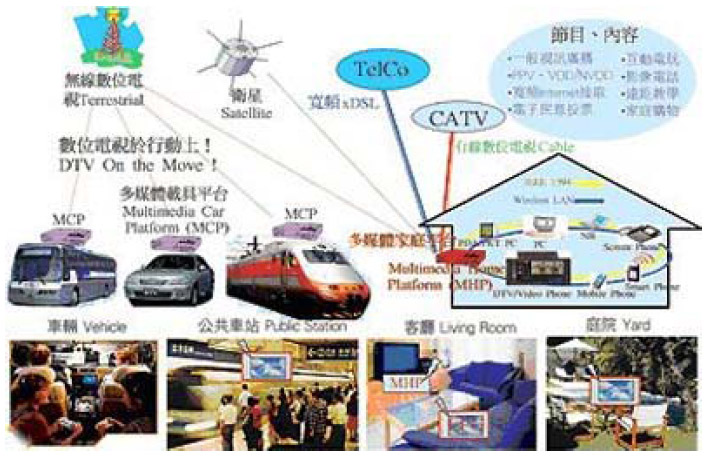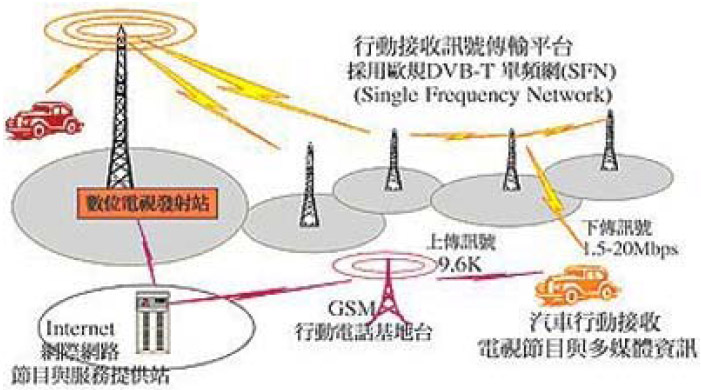Tag: Digital TV DVB-T
This article refers to the address: http://
Summary
In order to accelerate the development of the digital TV industry and establish an overall environment for digital TV, Taiwan decided to launch digital TV on November 10, 1997, and asked Taiwan's wireless TV station to broadcast digital TV signals in December 2001. It is expected that January 2006. When the digital audience penetration rate reaches 85% on the 1st, the existing analog TV signal transmission will be stopped and the digital signal transmission will be completely changed.
Foreword:
In order to accelerate the development of the digital TV industry and establish an overall environment for digital TV, Taiwan decided to launch digital TV on November 10, 1997, and asked Taiwan's wireless TV station to broadcast digital TV signals in December 2001. It is expected that January 2006. When the digital audience penetration rate reaches 85% on the 1st, the existing analog TV signal transmission will be stopped and the digital signal transmission will be completely changed.
Taiwan promoted the trend of digital TV. On April 18, 2003, Taiwan’s terrestrial wireless digital TV was launched. On July 1, 2004, five wireless digital TV stations in Taiwan were officially broadcast on multi-channel programs. In 2008, it was subsidized by the Information Bureau. The high-definition digital TV HIHD built by Public Vision was broadcasted on May 15th, but it has not yet been digitized.
The seemingly smooth digital TV signal transmission, compared with the time schedule, Taiwan's digital TV construction timeline has lagged behind, because of technical difficulties? There are still other considerations, resulting in delays in implementation, it is worth studying and thinking.
Digital television broadcasting technology
"Digitalization" is the conversion of a technology that previously transmitted audio and video as "analog signals" into a "binary" digital signal type consisting of only 0 and 12 digits. Converting to a binary signal mode can easily remove the noise and interference that are easily generated by the "analog signal", maintain the quality of the transmitted data, and have the advantages of compressible data and convenient transmission.
Traditional analog TV broadcasting can only transmit one program per channel, while the new digital TV technology can transmit at least three or more program content on one digital TV channel. After the digitalization of TV broadcasting, the quality and quantity of TV can be fully enhanced, value-added multimedia services, integrated communication and computer industry, and the development of more diversified business and business opportunities. The audience can combine with mobile phones to meet the needs of shopping and enjoyment. The two-way interactive function of the program can also be connected to digital devices such as the Internet.
There are two standards for traditional analog TV broadcasting, NTSC in the United States and PAL in Europe. Digital TV currently has three transmission standards, namely the ATSC system in the United States, the DVB-T system in Europe, and the ISDB-T system in Japan.
The difference between the three technologies is that the European system has a relatively superior advantage in terms of mobile reception. When the speed is 130 km, the TV program can still be watched. The European system can form a single frequency network (SFN), which improves the poorly-rated areas. The relay station is more advantageous; in contrast, the US system lacks these two technical features, but the technical content is simple; the Japanese system is an improved European system with similar performance to the European system.
Overview of the application of digital TV broadcasting technology in various places
Japan's ISDB-T technology is actually an improved product of the European standard DVB-T, but it also has the same three transmission methods as the European standard. The ISDB-T specification is currently only available in Japan and Brazil. The format of the US regulations is currently only used in North America, Canada, South Korea, etc. Most of the other regions are subject to European regulations, and the European regulations account for more than 80% of the global total.
One area is quite special, that is, the mainland develops a set of DMB-T/H systems on its own. The source of this digital TV system is the technical characteristics of European regulations and US regulations. It is currently used in mainland China, Hong Kong and Macao. .
The biggest problem with different specifications in different countries is that TVs or demodulators manufactured in different regions of the country cannot be used if they are in different TV signal format countries. In fact, this is not a phenomenon in the digital TV era. As early as the two major systems (European regulations and US regulations), TVs purchased in different regions will also be unusable.
However, the more troublesome part of digital TV is that it is currently in the transition period of analog to digital. It must also consider the type of TV. Is it possible to watch digital TV, or digital/analog coexist, or simply upgrade the old analog TV? Various manufacturing or integration methods are not unified, so the set top box (STB) will appear, using the old analog TV set, through the conversion decoding method, the old TV that can not support the digital TV signal It can also play digital TV program content.
In the end, whether it is built-in or external to deal with digital TV signal problems, it will also face restrictions in different areas, which may be unusable due to inconsistent specifications of signal sources in various regions of the world.
First of all, a TV set purchased from abroad can only be used as a general display (and should consider the analog European or American regulations), and then purchase the general set-top box to receive the video specifications in the region.
Current status of DVB specification in Taiwan Taiwan uses European DVB specifications, of which DVB is divided into three types, DVB-T (terrestrial) terrestrial wireless transmission, DVB-C (cable) cable transmission, DVB-S (satellite) It is the use of satellite transmission.

Caption: The way digital TV is transmitted. (Taiwan Digital Television Association)
Taiwan's DVB-T transmission, currently set up a digital TV signal transmission station in the 9 hills, because the area required for wireless TV coverage is large, so in addition to the 9 major hills in Taiwan, there are many other areas to set up the gap station, so the overall coverage rate It has reached 72%, and the outlying islands of Penghu can be successfully viewed, while the outer island areas, such as Kinmen and Matsu, are currently being prepared for erection.


Caption: Taiwan DVB base station radio wave coverage. (Taiwan Digital Television Association)
Digital image transmission changes viewing habits and locations
The implementation of mass vehicles to watch digital TV applications, for example, in the MRT system or public transport vehicles such as buses in various regions, has always had a similar concept in planning, but it is currently being tested in Kaohsiung. There is a public television digital TV signal transmitting platform on the 85 building in Kaohsiung City. This special building is for the city bus in Kaohsiung City. There is a special screen on the car for passengers to watch digital TV. Other 9 hills The transmitting stations shared by various TV stations are used.

Caption: The way DVB spreads makes action viewing easier. (Taiwan Digital Television Association)
In addition to the mass transit system and public building sites, the most common environment for people watching TV is the home. The classification of receivers can be roughly divided into three categories, including household, car and computer.
There are two types of households, which are combined with the display to be built into the display box and the traditional analog TV plus purchase box, and there is only one type of vehicle. The difference with the home is that the vehicle system will compensate the signal for the direction of the vehicle. And to be able to withstand the influence of external weather, such as temperature, humidity, etc., so the price will be higher than home.
The difference in computer use, analog to digital operation can be directly processed by the CPU inside the computer, eliminating the hardware cost of this part, so the volume will be smaller and the price is cheaper. The quality of the part, Taiwan's digital TV, currently playing SD standard picture quality, standard definition television (SDTV), but public television has been piloted high-definition television signal, referred to as HDTV, for high-quality digital Broadcasting, but currently the general set-top box still only has the function of decoding the SD picture, and decompresses the chip processing picture in MPEG-2 format. If you want to view the high-definition digital TV, the inside of the set-top box must have MPEG-4 solution. Video chip.
Watch the difference in movies with 3G or DVB-H
Some mobile phone models can directly receive digital TV. At present, digital TV audio and video can also be seen through the 3G network service of the telecom industry. In fact, most of these technologies can be used to watch programs by using base stations and then through telecom operators. It is slightly different from the operational logic of directly receiving digital TV.
Direct reception does not need to pass through the telecommunication industry network, but directly receives the radio broadcast TV signal. The advantage is that it will not cause image stoppage or delay due to congestion of the telecommunication network. This technology is also a kind of DVB, but only Because it is used for handheld mobile devices, it is called DVB-H, the same as the DVB-T architecture, and uses the same carrier, only the modulation mode is different, but still share the same one, these two technologies The key is that in the DVB-H design specifications, the battery life of mobile phones has been developed.
The DVB-H technology is that when the user switches channels and switches to which one, the decoder will solve which signal, and DVB-T decodes all channels at the same time, which consumes more power. Of course, if the DVB-T technology is directly used in mobile devices such as mobile phones, the power consumption for light consumption for decoding is considerable.
DVB-H technology can also be subdivided into three modes. The first one is based on TV stations, the telecom operators are the middle bridge, and the customers are managed, and the other is mainly based on the telecom industry. The digital TV signals are broadcast through the base station. The last one is that any company can participate, as long as the related services are provided through mobile phones or TV broadcasts, it is a new combination.

Caption: You can have different receiving channels by watching programs on your mobile phone. (Taiwan Digital Television Association)
Pipes and methods for collecting and broadcasting digital TV
Just like the transformation of society, the agricultural society has shifted to the industrial society. Due to the digitization of information, different types of networks and pipelines have increased and the complexity has increased. However, end consumers need to integrate a convenient application model to get the desired service. This part must have good and complete supporting measures.
Digital TV is not a simple product like a TV. Now, the terminal display products, in addition to TV, there are computers, mobile phones, car screens, etc., the variety of terminal interfaces is varied, and the intermediate communication channels are relatively more For diversity, the new business operation model is still in the process of exploration and development.
For example, mobile receiving applications, which will be an important market for digital TV. In the past, when only three wireless TVs were launched in Taiwan, the radio video channel resources were quite valuable. However, after the cable TV opened and new impact, let wireless The influence of TV is relatively weak. According to the analysis, about 80% of Taiwan's TV stations are currently watching cable TV. When adopting mobile receiving European-standard wireless TV specifications, as long as the program is refined, more people will be willing to watch.
The analog TV must complete the rating survey through the cable. If the viewing effect is not good, the advertisement will be reduced, leading to the dilemma of operation. Why did the three stations that belonged to the wireless network go to the cable broadcast, because the wired picture quality Better than the NTSC effect of analog broadcasting, but also consider not allowing cable TV stations to directly divide the market.
However, compared with digital TV broadcasting, the current ratings survey company does not conduct ratings surveys on digital TV channels. Therefore, the digital TV station's advertising revenue is not good. The main income still depends on the advertising revenue of the analog station to maintain the TV station operation.
At present, all industries related to digital TV are watching policies. If the government can actively lead, the industry will have the opportunity to develop rapidly. If the overall policy is unclear, the upstream manufacturers, downstream manufacturers, and even the audience will be at a loss. . Just like the two-way interactive function unique to digital TV, but currently due to regulations, only cable TV can charge, and wireless TV can not charge, so this function is equal to empty talk.
At present, the biggest problem in the development of digital TV in Taiwan is that there is no strong promotion of the policy, and there is still the burden of the old-time analog TV in the operation of the TV station. With the lack of commercial market promotion, the overall market development of digital TV is slowing down.
In the field of digital TV technology, the three most representative and representative organizations are the National Television System Committee (NTSC), the European Broadcasting Union (EBU) and the European Digital Broadcasting Organization (DBEG). (Digital Broadcasting Experts Group) Digital TV system is still in the trial stage in most countries, but it has decided to adopt the European standard system "DVB", while the US system "ATSC" is only available in North America, South Korea and a few countries. The Japanese standard system "ISDB" is only Japan and Brazil.
The main difference between the three systems is that the European system can be received by mobile. When using mobile TV in the car, the speed can reach 130 kilometers. In addition, the European system can form a single frequency network (SFN), and the viewing area can be expanded. Relay station. As for the early development of the US system, the technology is relatively simple. The Japanese system, which can be called the "improved European system", has similar performance to the European system. Although the number of countries implemented is small, the actual performance is not inferior. In addition to the above three major specifications, the mainland independently developed a set of digital communication technology DMB. This technology was established in August 2006 and is currently implemented in mainland China, Hong Kong and Macao. This system is used for broadcasting.
On March 31, 1997, Taiwan was originally decided by the Ministry of Communications to adopt the "US Regulation System". In June 2001, due to its technical neutrality, Taiwan agreed to adopt the "European Regulation System". The initial pilot project of the digital TV experimental platform was carried out by the TV Society in cooperation with the Ministry of Economics. The experimental platform was set up at the Huashi Zhuzishan Launching Station and was launched on June 27, 2000.
In May 2008, the public video broadcast high-definition HD TV. The resolution of normal-quality TV (SDTV) is 720×480, the ratio of the screen is 4:3, and the resolution of high-definition television (HDTV) is 1,920×1,080. The ratio is 16:9. The biggest difference between the two transmissions lies in the format. Therefore, if you want to watch the HD playback, in addition to the resolution requirements of the TV itself, whether the internal or the on-board box can handle the HD signal is also a key.

Ceramic fuses are made by porcelain and some metal materials. When a circuit breaks down or is abnormal, the current increases with the current and the increased current may damage some important components in the circuit, and it may also burn the circuit and even cause a fire. Fuse is small safety part in an electrical device or piece of machinery that causes it to stop working if the electric current is too high, and so prevents fires or other dangers. Fuse in the abnormal current increases to a certain height and heat, its own fuse to cut off the current, to protect the safe operation of the circuit fuse protection power equipment with current overheating damage, avoid electronic equipment serious damage caused by internal fault. If correctly placed in the circuit fuse, the fuse will be abnormal current increases to a certain height and heat, its own fuse to cut off the current, so as to protect the safe operation of the circuit.
Auto Ceramic Fuses
Auto Ceramic Fuses,Ceramic East Europe Fuse,Car Fuse Ceramic,Ceramic Fuse
Heshan Jianhao Lighting Industrial Co., Ltd. , https://www.sunclubtw.com
